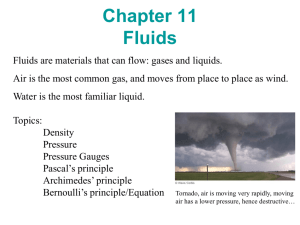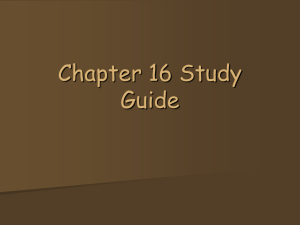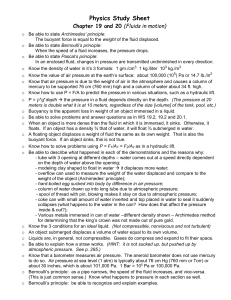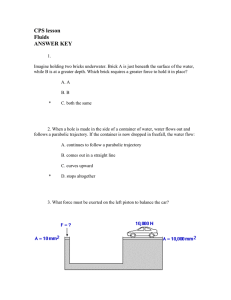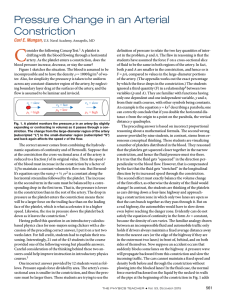Chapter 9 Fluids
advertisement
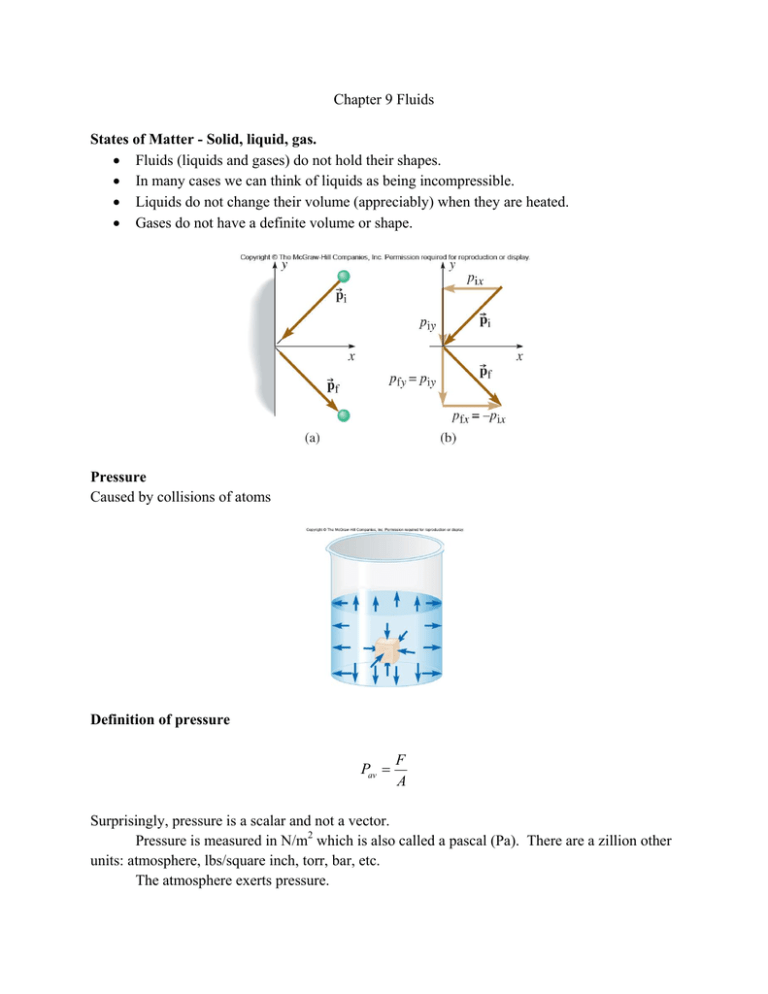
Chapter 9 Fluids States of Matter - Solid, liquid, gas. Fluids (liquids and gases) do not hold their shapes. In many cases we can think of liquids as being incompressible. Liquids do not change their volume (appreciably) when they are heated. Gases do not have a definite volume or shape. Pressure Caused by collisions of atoms Definition of pressure Pav F A Surprisingly, pressure is a scalar and not a vector. Pressure is measured in N/m2 which is also called a pascal (Pa). There are a zillion other units: atmosphere, lbs/square inch, torr, bar, etc. The atmosphere exerts pressure. 1 atm 1.013 105 Pa Pascal’s Principle A change in pressure at any point in a confined fluid is transmitted everywhere throughout the fluid. Pascal’s principle is the basis of hydraulics. Hydraulics are the most effective way to transmit a force. Modern Marvels (seen usually on the History Channel) has an excellent and entertaining discussion of hydraulics. Here is the link: http://www.youtube.com/watch?v=zoExXelcLGQ Density is the mass per unit volume. It is defined as m V Density is measured in kg/m3. As we descend down into a fluid the amount of fluid above us increases. That additional fluid pushes down and the pressure increases with depth. At depth d the pressure has increased P2 P1 gd Measuring Pressure A manometer consists of a U-shaped tube containing some mercury. When both sides are open to the atmosphere, the height in both arms are the same. When one side is connected to the pressure to be measured, the heights are different. The pressures at B are the same, PB PC gd Usually, the manometer is open to the atmosphere. It will measure pressures relative to atmospheric. The gauge pressure is the pressure above an atmosphere. Pgauge Pabs Patm Blood pressure is measured using a sphygmomanometer. The pressure in the cuff is higher than the systolic pressure – the maximum pressure in the brachial artery that occurs when the heart contracts. The cuff pressure squeezes the artery closed and not blood flows into the forearm. A valve on the cuff is then opened to allow air to escape slowly. When the cuff pressure decreases to just below the systolic pressure, a little squirt of blood flows past the constriction in the artery with each heartbeat. The sound of turbulent blood flow past the constriction can be heard through a stethoscope. As air continues to escape from the cuff, the sound of blood flowing through the constriction in the artery continues to be heard. When the pressure in the cuff reaches the diastolic pressure in the artery – the minimum pressure that occurs when the heart muscle is relaxed – there is no longer a constriction in the artery, so the pulsing sounds cease. Buoyant Force When an object is submerged in a fluid, the fluid pushes up on the object. The buoyant force is given by FB gdA gV Archimedes’ principle A fluid exerts an upward buoyant force on a submerged object equal in magnitude to the weight of the volume of fluid displaced by the object. We still need to use free body diagrams! The force F1 is the weight of the object. The specific gravity is defined as the ratio of the density of the material to the density of water. S.G. water If S.G < 1, the object will float. If S.G. > 1, the object sinks. Archimedes and the golden crown: http://www.youtube.com/watch?v=hIYdxQuzb60 The story: http://www.longlongtimeago.com/llta_greatdiscoveries_archimedes_eureka.html

